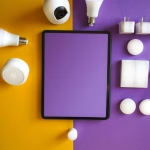Lighting does more than just brighten a room. It affects how we feel and interact with our surroundings. Whether at home, work, or public places, the right lighting can change our mood and the feel of a space.
This guide will show you how lighting can make us feel different emotions. It will also help you make your home’s lighting perfect for any occasion. Knowing how lighting affects mood can turn your living spaces into places of comfort and function.
The Impact of Lighting on Mood
1. Understanding the Psychology of Light
To understand how lighting affects mood, we must know its psychological impact. Light triggers biological processes and affects our sleep and alertness.
A. The Biological Effect of Light
Light influences two important hormones in our body—serotonin and melatonin. Natural light during the day boosts serotonin, improving mood and focus. As evening comes, dim light helps produce melatonin, helping us relax and sleep.
Artificial lighting can also affect these hormones. Bright, cool light boosts energy, great for workspaces. Warm, soft light is better for relaxing areas like bedrooms.
B. Color Temperature and Mood
Light’s color temperature—measured in Kelvin (K)—affects a space’s ambiance and mood. Color temperature shows the light’s warmth or coolness.
- Warm Light (2700K – 3000K): Warm lighting feels cozy and intimate. It’s perfect for bedrooms, dining rooms, and living areas where comfort is key.
- Neutral Light (3000K – 4000K): Neutral lighting is balanced and versatile. It works well in kitchens, bathrooms, and living rooms, where both function and comfort are needed.
- Cool Light (5000K – 6500K): Cool lighting, like natural daylight, boosts focus and productivity. It’s great for offices, study areas, and task-oriented spaces.
C. Brightness and Emotional Impact
Brightness also plays a big role in mood. Too much light can feel harsh, while too little can be gloomy. Finding the right balance is crucial for a positive mood.
- Bright Light: Bright light increases energy, making it perfect for workspaces, kitchens, and areas for reading or cooking.
- Soft Light: Soft light promotes relaxation, ideal for bedrooms or lounges where comfort is the priority.
2. How Lighting Affects Mood in Different Spaces
Lighting can change the mood of any room. Knowing how to adjust lighting for different areas is key to creating the right atmosphere. We’ll look at how lighting affects mood in various home spaces.
A. Living Room Lighting: Comfort and Versatility
The living room is a space for many activities. It needs lighting that can change to fit different needs, like relaxing or hosting guests.
Best Lighting Practices for the Living Room:
- Layered Lighting: Mix ambient, task, and accent lighting for a flexible space. A central light gives overall light, while table or floor lamps add warmth for reading or TV.
- Dimmer Switches: Dimmable lights let you adjust brightness for different times or activities. This makes sure the light is right, not too bright or too dim.
- Accent Lighting: Wall sconces or spotlights highlight artwork, plants, or features, adding depth and interest.
B. Kitchen Lighting: Functionality and Energy
Kitchens are busy and need bright, useful lighting. This helps with efficiency and focus.
Best Lighting Practices for the Kitchen:
- Task Lighting: Bright, focused lights are key for food prep and cooking. Under-cabinet LED lights and pendant lights over the island provide focused light for tasks.
- Bright Ambient Lighting: A ceiling light with cool, neutral light makes the whole kitchen bright for daily tasks.
- Energy-Efficient Lighting: LED bulbs are bright but use less energy. They make the kitchen functional and eco-friendly.
C. Bedroom Lighting: Relaxation and Calm
The bedroom is a place for comfort and rest. Lighting is crucial for creating a peaceful atmosphere.
Best Lighting Practices for the Bedroom:
- Warm Light for Bedside Lamps: Warm, soft lighting for bedside tables creates a calm atmosphere for unwinding. Adjustable lamps are great for reading in bed without disturbing your partner.
- Smart Bulbs with Sleep Settings: Smart lighting systems that dim as bedtime approaches help you sleep better. They mimic daylight and encourage melatonin production.
- Accent Lighting: Soft, low-light fixtures like string lights, wall sconces, or candles add coziness and set a relaxing mood.
D. Home Office Lighting: Focus and Productivity
Good lighting in a home office boosts focus and reduces eye strain. This leads to better productivity.
Best Lighting Practices for the Home Office:
- Cool, Bright Light: Cool-toned, bright lighting keeps you alert and focused. Desk lamps with adjustable heads direct light for specific tasks.
- Natural Light: Place your desk near a window to get natural light. It improves concentration and mood.
- Task Lighting: Task lighting on work surfaces reduces the need for overhead lights and prevents glare on screens.
E. Bathroom Lighting: Clarity and Relaxation
Bathrooms need both functional and relaxing lighting. This balances grooming tasks with moments of calm.
Best Lighting Practices for the Bathroom:
- Bright Vanity Lighting: Bright, neutral lighting around mirrors ensures even, shadow-free light for grooming.
- Soft, Ambient Lighting: Soft, dimmable lights create a calming atmosphere for baths or unwinding.
- Waterproof Fixtures: Use waterproof lighting in wet areas like the shower or bathtub for safety and longevity.
F. Outdoor Lighting: Safety and Ambiance
Outdoor lighting makes your home safer and more beautiful. It adds to the feel of your outdoor spaces.
Best Lighting Practices for Outdoor Areas:
- Path Lighting: Use low-level, energy-saving LED lights on walkways and driveways. They help you see and make your home look welcoming.
- Motion-Sensor Lights: Place these lights by entryways and garages. They turn on when someone comes near and keep intruders away.
- String Lights and Lanterns: Add these to your patio or seating areas. They create a cozy, festive vibe.
3. How to Create the Perfect Atmosphere with Lighting
To make your home feel just right, learn how to use lighting. The right lights can make any event special, whether it’s a party or a quiet night in.
A. Use Dimmers to Control Mood
Dimmer switches are easy to use and change a room’s feel. You can go from bright and lively to calm and intimate with just a switch.
Benefits of Dimmer Switches:
- Versatility: Dimmers let you quickly change the lighting in rooms like living areas or dining rooms.
- Energy Savings: Dimming your lights saves energy and cuts down on your electricity bill. It also helps create the perfect mood.
B. Play with Lighting Layers
Layering lighting means using different types of lights. This makes your space look good and feel right for any activity or mood.
The Three Layers of Lighting:
- Ambient Lighting: This is the main light in a room, like ceiling lights. It sets the room’s brightness.
- Task Lighting: This light is for specific tasks, like reading or cooking. Think desk lamps or under-cabinet lights.
- Accent Lighting: This highlights special features or decorations. Use spotlights or LED strips for this.
C. Experiment with Smart Lighting
Smart lighting systems, like Philips Hue or Nanoleaf, let you customize your lights. You can change colors, brightness, and timing with an app or voice assistant.
Benefits of Smart Lighting:
- Convenience: Set your lights to match your day, like waking up to a sunrise or dimming for movie night.
- Customizable Colors: Change your lights to fit any activity. Warm tones for cozy nights, cool tones for work.
- Energy Efficiency: Smart bulbs save energy and can turn off when not needed, cutting down on waste.
4. Final Thoughts: Lighting for Well-Being
Lighting greatly affects our mood and well-being. By choosing the right lights, you can make your home more comfortable and joyful. Every room can benefit from good lighting, from cozy lamps to bright office lights.







I recently transformed my space with Big Wall Decor, and the experience was fantastic! Their team was supportive and knowledgeable, helping me choose the perfect wallpaper that truly reflects my style. The quality of the wallpaper is top-notch, and it has completely revitalized my room. I highly recommend Big Wall Decor for anyone looking to elevate their home!
L’impact de l’éclairage sur l’ambiance : Comment créer l’atmosphère parfaite
Cet article explore brillamment l’importance de l’éclairage dans la création d’une ambiance idéale. Il propose des conseils pratiques sur le choix des lumières adaptées pour chaque espace, que ce soit pour une atmosphère chaleureuse, dynamique ou relaxante. Une lecture essentielle pour sublimer votre intérieur grâce à un éclairage bien pensé !
Explore a variety of Kids Game designed to entertain and engage children of all ages. Our games are perfect for family fun and skill development.